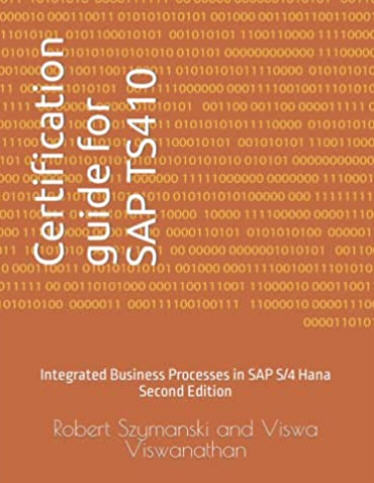The book has the following chapters:
The Big Picture
- Study Strategy
- Setting the stage
- So, what is this book about?
- Key process flows
- Generic process structure in SAP
- Configuring and customizing an ERP system
- Organization levels in SAP
- The Evolution of SAP ERP
- S/4HANA Simplified Data Model
- Simplification List...
- New User Experience
- Introduction
- Organizational Data
- Master Data
- Transactions
- Financial Statements and Summary
- Management Accounting Organizational Levels
- Management Accounting Master Data
- Cost Element Accounting
- Overhead Cost Controlling
- Profit Center Accounting
- Profitability Analysis
- Product Cost Controlling
- Management Accounting Other Transactions
- Management Accounting Summary
- Materials Management — Procurement Organizational Levels
- Materials Management — Procurement Master Data
- Materials Management — Procurement Process
- Materials Management — Procurement Summary
- Human Capital Management (HCM) Organizational Levels
- Human Capital Management (HCM) - Master Data
- Human Capital Management (HCM) - Transactional Data
- SAP SuccessFactors
- Warehouse Management Organizational Levels and Master Data
- Warehouse Management and Extended Warehouse Management
- Transfer Postings and Stock Transfers
- Organizational Levels
- Master Data
- Transactions/Processes
- Manufacturing Execution Process
- Organizational Levels
- Master Data
- Sales Process (Transactions)
- Sales and Profitability
- Transportation Management
- Organizational Levels
- Master Data
- Transactions
- Organizational Levels
- Master Data
- Transactions
|
Author's background and qualifications The Certification guide for SAP TS410 Integrated Business Processes in SAP S4 Hana was authored by Robert Szymanski and Viswa K Viswanathan, both of whom are experts in SAP technology and business processes. Robert Szymanski is an SAP consultant and trainer with over 15 years of experience in SAP technology and business processes. He has worked with clients in a variety of industries, including manufacturing, retail, and healthcare. Viswa K Viswanathan is an SAP consultant and trainer with over 20 years of experience in SAP technology and business processes. He has worked with clients in a variety of industries, including utilities, oil and gas, and public sector. Both Robert Szymanski and Viswa K Viswanathan are certified SAP professionals with extensive experience in SAP technology and business processes. They hold multiple SAP certifications and have worked with clients in a variety of industries to implement SAP solutions and improve business processes. |
 |